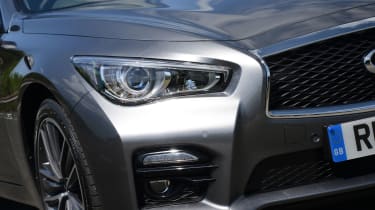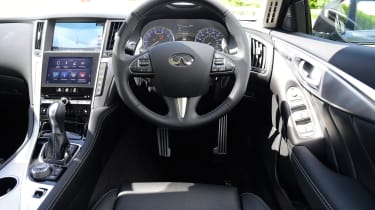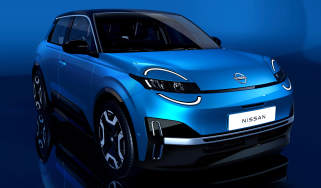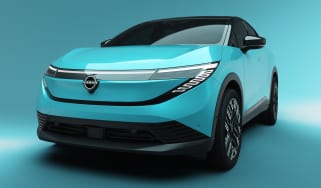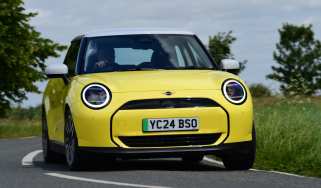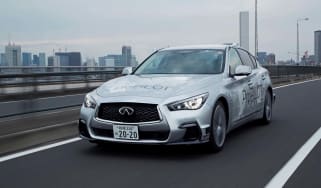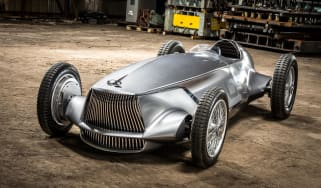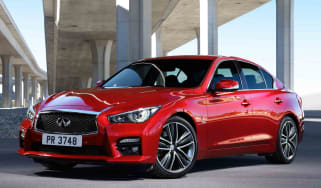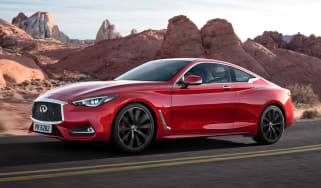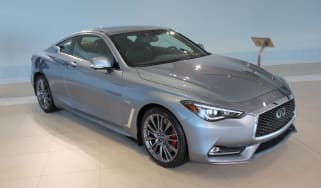Infiniti Q50 saloon (2013-2019)
"The Infiniti Q50 is a small executive saloon that offers great quality but a dull driving experience"
Pros
- Quiet and comfortable inside
- Plenty of rear legroom
- Well equipped
Cons
- Steering lacks feel
- Noisy diesel engine
- Hybrid version is expensive
Taking the fight to executive saloons like the Audi A4, BMW 3 Series and Mercedes C-Class the Infiniti Q50 hasn’t picked an easy battle, but its unique styling, rarity and generous kit count towards its appeal.
Its major flaw, however, is the driving experience and how much the car disappoints out on the open road. There’s an odd sensation from the steering wheel, with little feel for the road, and the Q50 has a rather limited engine line-up. The single diesel is our pick of the bunch, while there’s also a pricey hybrid and either a 2.0 or 3.0-litre turbocharged petrol to choose from.
On paper, the Infiniti isn’t too far off the performance and economy of rivals from Audi and BMW. It can also compete on build quality, but the numb steering and unrefined diesel will put off many potential customers, particularly when you consider how well other cars in this class drive.
There are quite a few trim levels available, starting with SE and moving up through Premium, Premium Tech, Sport and Sport Tech. Some of the trims are only available with certain engines. Standard equipment is generous though, with a colour infotainment system, reversing camera and attractive alloy wheels.
MPG, running costs & CO2
The Infiniti Q50 comes with a choice of four engines: a 2.1-litre diesel (which is, oddly, badged as a 2.2), a 2.0-litre or 3.0-litre petrol and a 3.5-litre hybrid petrol. The diesel engine is capable of up to 65.7mpg and emissions of just 114g/km CO2, meaning company car drivers will be liable for a reasonable Benefit-in-Kind rate of 22% - though note this this increases to 24% if you choose the range-topping automatic. Coupled with a low starting price and the availability of a manual gearbox (it's the only engine so-equipped), this makes it the top seller in the UK. It's also the only Q50 engine we'd really recommend.
More reviews
In-depth reviews
The hybrid is much less efficient, with Infiniti claiming 46mpg and at least 139g/km of CO2. Although it's considerably more powerful and can be specified with a four-wheel drive system, it's hard to make a case for the hybrid purely in financial terms.
There's also a 2.0-litre turbocharged petrol engine that's only marginally more expensive to run than the hybrid. Infiniti says it's capable of 43.5mpg on average and its CO2 emissions of 151g/km. Go for the 3.0-litre turbo-petrol, meanwhile, and economy drops to just 31mpg.
All Infiniti Q50s attract road tax of £140 a year, except the hybrid model which qualifies for £130 yearly payments. Those with a list price (including options) of more than £40,000 are liable for an additional surcharge of £310 for five years, bringing the annual bill to £450 during that period (or £440 for the hybrid).
Engines, drive & performance
Infiniti's hopes that the Q50 would be more exciting to drive than the brilliant BMW 3 Series have been dashed by its steering. There's very little feedback transmitted through the front wheels to the driver, and as such this car is unable to offer the same sort of involving drive you get in most of its rivals.
You can spend another £800 on an 'adaptive' steering option, but if anything this makes the steering feel worse. Plus, technologies such as lane-keeping assistance and distance control to the car in front are too intrusive and sometimes get in the way of normal driving.
The performance of the 168bhp diesel engine is little more than reasonable, with a 0-62mph time of 8.5 seconds. The automatic version is fractionally slower, but not by enough to be really noticeable.
So the diesel isn't particularly quiet or smooth, but fortunately the 208bhp petrol model is. It has a 7.2-second 0-62mph time, which is broadly in line with equivalent BMW 3 Series models. Frustratingly, this engine is only available with an automatic gearbox, which doesn't shift as precisely as a BMW or Audi automatic.
The hybrid is impressively fast, with a 5.1-second 0-62mph (although choosing four-wheel drive increases this marginally). It's possible to drive on electric power alone at low speeds and when the engine does kick in, you'll barely notice. Under hard acceleration, the Q50 feels powerful and muscular.
The 399bhp 3.0-litre turbo-petrol Q50s is also quick (its 0-62mph time is identical to the hybrid’s), but this level of performance arguably highlights the Q50’s handling deficit further. It’s expensive to buy, uneconomical to run and hard to recommend.
Interior & comfort
The Q50 uses an active noise-cancelling system to drown out unwanted engine din, so it's pretty quiet once you're up and running. Unfortunately, the setup doesn't work too well under hard acceleration so you still get quite a noisy, rough-sounding note from the four-cylinder diesel. The petrol and hybrid models are far better in that respect, while the hybrid can run near-silently on electric power at low speeds.
The suspension has been carefully tuned to isolate you and your passengers nicely from any bumps in the road. It feels slightly firm, but you can travel over a rough road with very few vibrations shaking the interior - though it's not as smooth around town as its rivals. The steer-by-wire system may not be the best for handling, but it has allowed Infiniti's engineers to dial out unwanted 'kickback' when travelling over big potholes or bumps. As a result, you never feel the wheel tugging in your hands; some may welcome this kind of refinement, but others will find it unusual.
As you'd expect from an executive car, the Infiniti Q50 comes with plenty of hi-tech equipment. The dashboard and centre console is dominated by a pair of touchscreens. The upper screen is an 8-inch number that features all of the car's main functions, while the lower 7-inch screen controls things like the settings for sat-nav etc. The lower screen is very bright and crisp and pretty responsive, but the glossy finish can show up fingerprints and reflections, while the upper screen has a matt finish and can appear a little grey.
The system itself can be a little sluggish to respond and move between menus, but it's not too bad overall. You can also control the screens via a scroll wheel on the centre console, so there are plenty of options.
The sat-nav is impressive in the Q50. The main map is shown on the upper screen, allowing you to change route options or other settings on the lower screen. It's not much, but it means the route map remains visible if you want to change anything. The voice control is very clear and easy to use, and you can also configure how many instructions you want, so it can be as informative (or not) as you like.
Practicality & boot space
The Infiniti Q50 has a large 500-litre boot – bigger than what you get in the BMW 3 Series or Audi A4. The rear seats fold down to increase luggage space and non-hybrid models get a ski hatch, too.
The back seats are very roomy and will comfortably fit adults. You can specify a steering system that lets you adjust the weight and speed of the steering, which helps when driving in town, but as it's not a simple touch-of-a-button system, it won't be massively useful for quickly nipping into a parking spot. The car comes with parking sensors as standard, though, so tight gaps shouldn't pose any problems.
Reliability & safety
Infiniti is part of Nissan and all its cars are aimed at the premium rather than mainstream market. But many parts are shared across both brands and have already been proven in various Nissans over the last few years. Nissan ranked 28th out of 32 manufacturers in our 2015 Driver Power customer satisfaction survey, which was a disappointing result. Of its individual models, only the Nissan LEAF electric car and Nissan Juke small SUV finished in the top half of the top 200 cars, while the rest of its models covered by the survey (Note, Qashqai and X-Trail) finished poorly.
Some of Infiniti's interior features are sourced from cheaper Nissan cars, but overall the build quality feels much better than older Infiniti models.
The Q50 scored well in Euro NCAP crash-testing, with a full five-star rating. Its 86% score for adult protection and 85% result for child protection are impressive. The organisation also awarded the car 81% for safety equipment, which includes six airbags.
It's just a shame that Infiniti's Safety Shield Pack is only available on the Premium Tech and Sport Tech models. This pack brings a range of crash-mitigation systems, such as automatic emergency braking.
Price, value for money & options
The Infiniti Q50’s entry-level model costs a lot more than the starting price of the BMW 3 Series and Audi A4. That's a bit misleading, though, because if you look at the models most similar to the Q50 2.2d – the BMW 320d and Audi A4 2.0 TDI – rather than the entry-level cars, then the prices are about the same.
The Infiniti is better equipped, too, with features like parking sensors, a rear-view camera, air-conditioning and two touchscreens included. You only need to move up from basic SE to mid-spec Premium to get full leather upholstery, too. The Hybrid model also represents better value than the BMW 3 Series ActiveHybrid, thanks to a lower price tag and more generous kit list.

